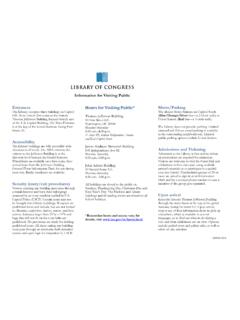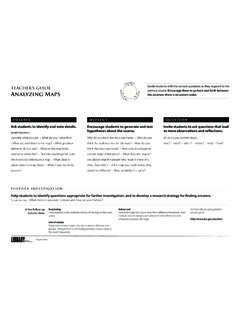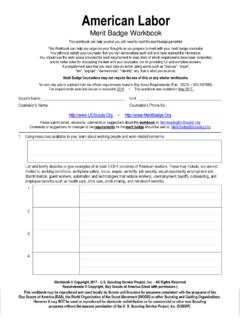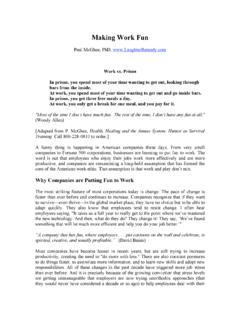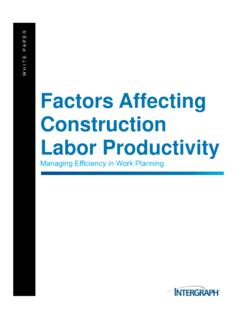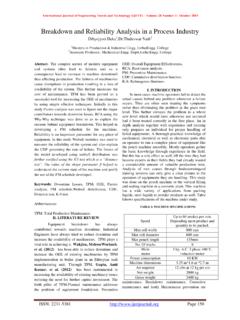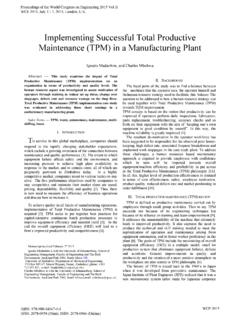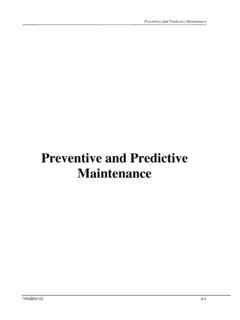Transcription of The Industrial Revolution in the United States - Teacher Guide
1 Teacher 's Guide primary source set The Industrial Revolution in the United States The Industrial Revolution took place over more than a century, as production of goods moved from home businesses, where products were generally crafted by hand, to machine-aided production in factories. This Revolution , which involved major changes in transportation, manufacturing, and communications, transformed the daily lives of Americans as much as . and arguably more than any single event in history. Breaker boys, Woodward Coal Mines det1994007312/PP/. Historical Background An early landmark moment in the Industrial United States increased at a breakneck pace. This Revolution came near the end of the eighteenth period, encompassing most of the second half of century, when Samuel Slater brought new the nineteenth century, has been called the Second manufacturing technologies from Britain to the Industrial Revolution or the American Industrial United States and founded the first cotton Revolution .
2 Over the first half of the century, the mill in Beverly, Massachusetts. Slater's mill, like country expanded greatly, and the new territory many of the mills and factories that sprang up in was rich in natural resources. Completing the first the next few decades, was powered by water, which transcontinental railroad in 1869 was a major confined Industrial development to the northeast at milestone, making it easier to transport people, raw first. The concentration of industry in the Northeast materials, and products. The United States also had also facilitated the development of transportation vast human resources: between 1860 and 1900, systems such as railroads and canals, which fourteen million immigrants came to the country, encouraged commerce and trade.
3 Providing workers for an array of industries. The technological innovation that would come to mark The American industrialists overseeing this the United States in the nineteenth century began expansion were ready to take risks to make their to show itself with Robert Fulton's establishment of businesses successful. Andrew Carnegie established steamboat service on the Hudson River, Samuel F. B. the first steel mills in the to use the British Morse's invention of the telegraph, and Elias Howe's Bessemer process for mass producing steel, invention of the sewing machine, all before the Civil becoming a titan of the steel industry in the War. Following the Civil War, industrialization in the process. He acquired business interests in the mines 1 that produced the raw material for steel, the mills themselves at home, in a small shop, or outdoors, and ovens that created the final product and the crafting raw materials into products, or growing railroads and shipping lines that transported the a crop from seed to table.
4 When they took factory goods, thus controlling every aspect of the steel- jobs, they were working for a large company. The making process. repetitive work often involved only one small step in the manufacturing process, so the worker did not Other industrialists, see or appreciate what was being made; the work including John D. was often dangerous and performed in unsanitary Rockefeller, merged conditions. Some women entered the work force, as the operations of many did many children. Child labor became a major issue. large companies to form a trust. Rockefeller's Dangerous working conditions, long hours, and Standard Oil Trust came concern over wages and child labor contributed to to monopolize 90% of the growth of labor unions. In the decades after the industry, severely John D.
5 Rockefeller, full-length the Civil War, workers organized strikes and work limiting competition. portrait, walking on street with stoppages that helped to publicize their problems. John D. Rockefeller, Jr. These monopolies One especially significant labor upheaval was the were often accused of Great Railroad Strike of 1877. Wage cuts in the intimidating smaller businesses and competitors in railroad industry led to the strike, which began in order to maintain high prices and profits. Economic West Virginia and spread to three additional States influence gave these Industrial magnates significant over a period of 45 days before being violently political clout as well. The government adopted ended by a combination of vigilantes, National policies that supported Industrial development such Guardsmen, and federal troops.
6 Similar episodes as providing land for the construction of railroads occurred more frequently in the following decades and maintaining high tariffs to protect American as workers organized and asserted themselves industry from foreign competition. against perceived injustices. American inventors like Alexander Graham Bell The new jobs for the working class were in the and Thomas Alva Edison created a long list of cities. Thus, the Industrial Revolution began the new technologies that improved communication, transition of the United States from a rural to an transportation, and Industrial production. Edison urban society. Young people raised on farms saw made improvements to existing technologies, greater opportunities in the cities and moved there, including the telegraph while also creating as did millions of immigrants from Europe.
7 Providing revolutionary new technologies such as the light housing for all the new residents of cities was a bulb, the phonograph, the kinetograph, and the problem, and many workers found themselves electric dynamo. Bell, meanwhile, explored new living in urban slums; open sewers ran alongside speaking and hearing technologies, and became the streets, and the water supply was often tainted, known as the inventor of the telephone. causing disease. These deplorable urban conditions gave rise to the Progressive Movement in the early For millions of working Americans, the Industrial twentieth century; the result would be many new Revolution changed the very nature of their daily laws to protect and support people, eventually work. Previously, they might have worked for changing the relationship between government and the people.
8 2 Suggestions for Teachers The Industrial Revolution is a complex set of economic, technological, and social changes that occurred over a substantial period of time. Teachers should consider the documents in this collection as tools for stimulating student thinking about aspects of the Industrial Revolution . After providing a definition of the Industrial Revolution and explaining the time span across which it took place, teachers might supply small groups of students with a set of the documents in this primary source set. Students can categorize the documents by whether they provide information about what happened, why it happened, or its effects. Some documents may fit into more than one category. When small groups have completed their work, the Teacher can facilitate creating a class list of events of the Industrial Revolution , causes (or supporting factors), and effects.
9 Students may search the Library's online collections to find additional evidence to support the causes and effects on the class chart. The great railroad strike of July 1877. item/2007675388/. Using the documents in this primary source set, students can create a timeline of important events in the Industrial Revolution . The last document in the set is dated 1919. Was the Industrial Revolution over by 1919? Challenge students to find evidence in the Library of Congress digital collections to support their answer (there are documents that suggest industrialization in the South was still taking place into the 1930s). Understanding a historical event as it was experienced by those who lived through it is an important skill of historical thinking and one that can be difficult to develop.
10 Teachers may challenge students to study documents in the collection to identify varied perspectives on the changes brought by the Industrial Revolution , as experienced by people of the day. Would students classify the responses as mainly positive, mainly negative, or about equally divided? How did people respond to what they perceived as negative effects of the Industrial Revolution ? In 1893, Chicago hosted the World's Columbian Exposition, which highlighted achievements of the United States and other nations in a variety of fields, including manufacturing and technology. An entire building was devoted to electricity. Using the primary source set as a starting point, ask students to design an exhibit about the development of American industry for the World's Columbian Exposition.


